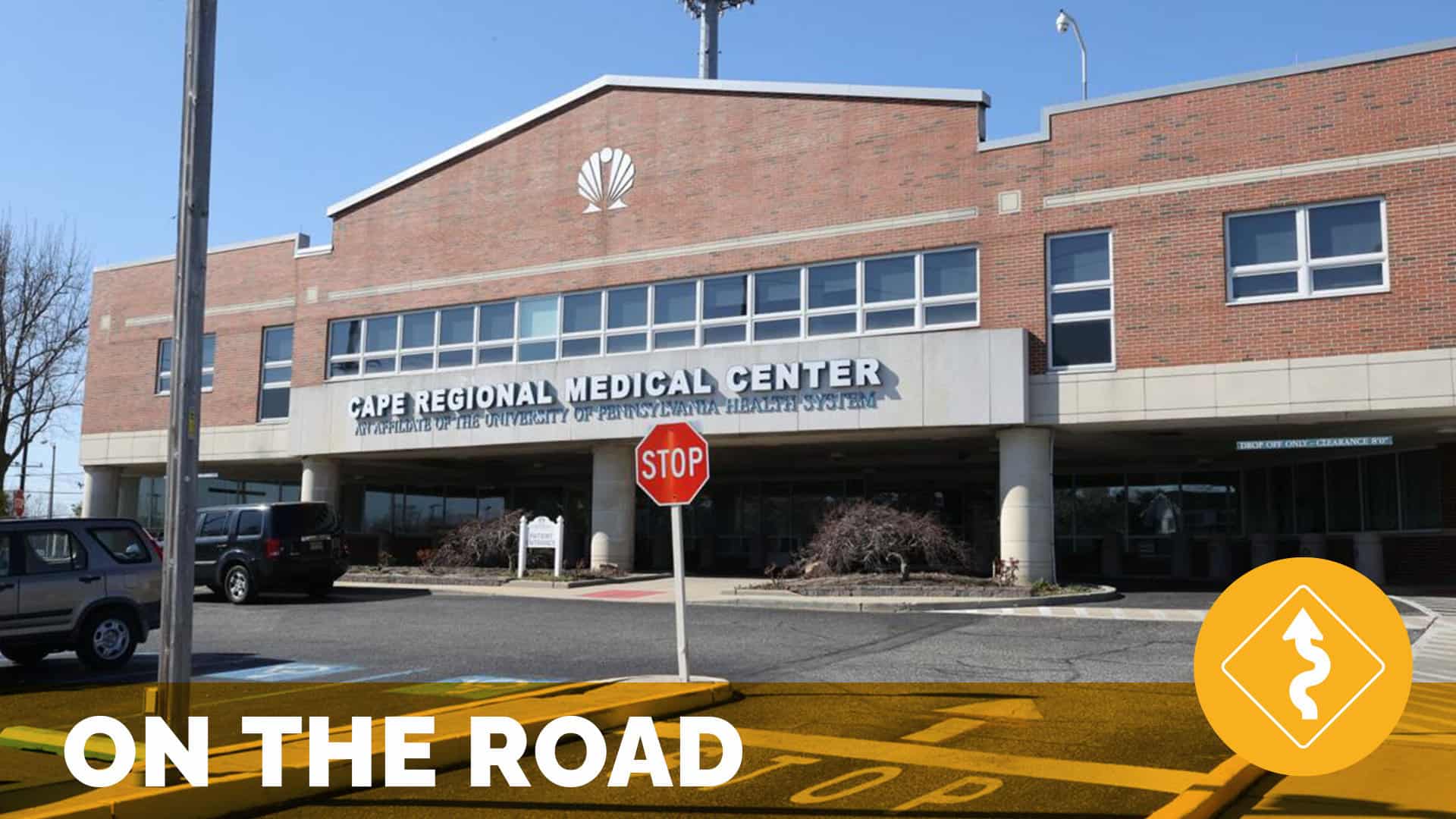Linking Community & Clinical Excellence for a Positive Patient Experience

On the Road with Cape Regional Medical Center – June 2014
by Jason A. Wolf, Ph.D.
My latest On the Road led me to the southern tip of New Jersey and the nearby beaches of Cape May County. It was an exciting trip for me as it was a place I had spent visiting with my grandparents one week a summer as a child. What I was not aware about then, but what I experienced on this visit, was an incredibly committed community center of care – Cape Regional Medical Center.
My visit to Cape Regional, guided by my host, Corinne Robinson Director, Patient Satisfaction took on a unique, but important perspective that I have not often experienced during my series of On the Roads. At Cape Regional I was introduced to powerful examples of clinical excellence at the foundation of providing the best in experience and through those efforts saw the true sense of community Cape Regional exemplified. This was not just a sense of community among staff, but an unwavering commitment to the community they served. This is even more dynamic when you consider that Cape Regional’s population served jumps from a wintertime low of just under 100,000 to over 800,000 during the summer season.
This passion to serve the needs of and engage the community, while providing leading edge and highly recognized and respected services reinforced an issue at the foundation of many effective patient experience efforts. We must first know (and anticipate) the needs of our consumers – the patients, families and communities we serve – as well as those of our own team members to ensure the best in experience and we must ground our efforts on a firm foundation of clinical excellence. It is the intersection of these concepts I often address – the integration of quality, safety and service – that represents the comprehensive nature of patient experience.
Creating Experience Through Clinical Excellence: Three Cases
On my visit I was introduced to three innovative and recognized efforts that epitomize how we can link anticipating needs and addressing clinical opportunities with a true commitment to the community. These services include Diabetes Care and Education, an Anti- Thrombosis service and Wound Care Services. Through these three cases, we looked deeper than many of the typical paths to experience performance to the foundational elements of care.
Impacting Wellness and Health: Diabetes Center
I was able to spend time with Cindy Kraemer BSN, CDE, PRNC, Manager of the Diabetes Center. The team at the Center shared the story of not only building a program that addresses one of the biggest health needs of the broader community Cape Regional serves, but also of a proactive effort to address the potential health and wellness needs of patients in the facility itself.
The Diabetes Center includes direct monitoring and interventions with current patients, community education programs and now intentional linkages to post-acute care settings. All of these efforts are designed to take a systemic and active approach to address the needs of those managing and living with diabetes. As one of just a few recipients of The Joint Commission’s Disease Specific Certification Gold Seal of ApprovalTM in this area, the diabetes program exemplifies a forward thinking approach to addressing experience across the continuum and across settings.
While I will not discuss every service offering or clinical detail, what did stand out was the comprehensive nature of the program overall. As a home grown effort (and a powerful model to follow for those looking to drive excellence in diabetes care and education), it engaged a broad level of voices from caregivers to recipients of care, its takes a personal and active approach to address the needs of people in care and it exemplified generosity of spirit in providing the best in health for the community. It also has direct implications for key quality and service measures regarding communication and understanding of care needs as well as impacting the potential for readmissions as well. This is reinforced by the Diabetes Center’s team working to ensure that any patient they engage have a follow-up appointment no more than 24 hours post discharge.
This linkage of purposeful clinical effort, while addressing the unique and personal needs of each patient reinforces this example as more than an education program to an experience excellence exemplar. This may be no better represented than in the words of Cindy Kramer herself when she shared, “We are a community at Cape Regional and we just want what is best for the patients, their families and the community we serve.”
Providing Proactive and Timely Service Anti-Thrombosis Service
This same commitment was seen in an innovative idea being implemented via the facility’s pharmacy under the direction of Rich Artymowicz, PharmD, Director, Pharmacy Services. While a pharmacy managed Coumadin clinic is not a new service, it’s a rarity to find one in New Jersey. The Anti- Thrombosis Clinic provides a service that normally took place in an outpatient clinic setting, which could lead to longer wait times and other potential delays. The clinic was a concept designed to actively schedule patients, see them in a timely manner to administer medications, monitor blood levels and ensure patients were aware of what they needed to take and confirm they were prepared for their next appointment.
Again, built on clinical needs and providing the best in outcomes, the process itself was designed to ensure the best in experience. By providing quality and timely interactions with patients in the clinic, their services are in high demand. And the people delivering these clinical services are at the forefront of providing personal touch and care in the clinical encounter. As Rich shared, “It is the people up there that have really made it successful. They take the time to engage each patient as an individual, while still managing our commitments in a timely manner.” This is a service that will continue to see great demands as a proactive clinically based experience effort.
Meeting Patients at their Point of Need: Wound Care
In meeting with the wound care team, I saw another case of actively addressing community need with an innovative and interactive care service, driven by the power of personal interaction and support and grounded in the importance of engaging all members of the care team and facility community to address the issue of wound care overall.
I had the chance to meet with Jeff Andrews, Director Rehabilitation Department and wound specialists Judy Horn PT, DPT, CWS/WCC and Marc Miller PT, DPT, WCC to learn about the effort to build and grow an active wound care center for the community. The foundation of this effort, presented by Judy, reinforced much of the message I encountered during this On the Road. She shared, “In order for us to get the patient experience right, we have to ensure all the other little pieces are working to support it.”
In this case, a great example of these words in action came again not from the rigorous clinical standards exemplified by the work of the team, though clearly central to their ability to deliver the best in outcomes. Rather what I experienced and learned from Judy and the team reached beyond the nature of care they provided. For example I saw one patient coming in for her last appointment and hugging her therapist, saying how she would miss her after they were done.
More impressive was the sense of ownership this team provided for others in the facility about the critical roles they played in wound care and wound prevention. Judy created the Skin Team and Resource Staff, know at Cape Regional as STARS. These interdisciplinary caregivers provide extensive direct education, resources, and reinforce information to proactively address wound issues. Rather than prevention and wound care being an after the fact experience, the facility was turning the process inside out to focus on “enhancement of timely care at the bedside for prevention and treatment.”
This effort again exemplified Cape Regional’s focus on experience by actively engaging in innovations around clinical excellence, but by showing the willingness and innovation to stretch beyond typical boundaries of delivery to creating mechanisms to engage patients, families and the community in unique and important ways. The wound care program as with the other cases backed up plans and actions with clear outcomes. For example, a significantly reduced and sustained low level of pressure ulcers was one impact they are having through these efforts. As Judy closed our conversation she reinforced, “This has been truly an organization-wide commitment and effort. We cannot do this in silos.” As we saw in all three examples, it was about thinking forward and about engaging the broadest reach of the care team in innovative ideas and possibilities that great experiences can be created.
Translating the Experience to the Front Door
From these direct clinical services, I had the chance to visit with Mary Osler, RN, CEN, Director Emergency Services and learn about the efforts they put in place to drive rapid improvement in their Emergency Department (ED) efforts around experience. I consistently hear how organizations are working at improvements in their EDs, as both the unofficial front door to their facilities and the units that oftentimes can touch the greatest number of patients and impact community reputation.
At the Cape Regional ED, they acknowledged the need to turn their scores around and took on some simple, yet high impact efforts to ensure rapid change. Key actions included the addition of a Quick Look Nurse. This was a nurse assigned to the front of the ED as a greeter and pre-triage filter to determine where the patient could best be served based on acuity or situation. The commitment they took on was to triage forward, meaning once in you proceed downstream versus back to your seat in the waiting room.
Creating a sense of movement was important to the team, so various layers of care were created including what I have seen in other facilities in the form of fast track. What I saw for the first time at Cape Regional and would love to learn from the examples of others who may be doing this, is the concept of Quick Care. In my layman’s terms, this is in essence an urgent care clinic within the ED, where based on diagnosis, patients can be quickly seen for lower acuity issues not requiring an actual bed space in the ED itself.
By providing streams of care and means by which to address the variety of needs appearing at the door, Cape Regional has garnered a reputation of both speed and attentiveness. The result has been rapidly improving patient survey scores (75th%ile rank in 2012 to 96%ile rank in 2013) and as Mary said, “the broader engagement of staff members.” The changes made it easier to do what can be a stressful job, provided for more coordinated action and enabled the best in experience for all who enter the doors.
Striving for Excellence in Experience
As I was wrapping up my visit I had the chance to speak to and share my observations with Joanne Carrocino, FACHE, President & CEO and Deborah Baehser, RN, MSHA, Vice President, Patient Care Services. We discussed my observations and I asked them for their perspective on the facility overall. I was not surprised to hear much of what I saw during my day reinforced in their words.
Joanne offered, “We are ultimately a true community hospital. What makes us strong is that we understand we are community members, caring for community members.” This was a clear summation of so much of what I saw in action. The power and commitment of people across the facility, not only on the basic experience efforts, but also in the innovative clinical services, underlined the sense of commitment to the community in the broadest sense.
Deborah reinforced this by adding, “We are not just a hospital, we are much more. We represent and care for our community and at our core is a culture of caring.” This idea of culture of caring has a great dual meaning in what I saw at Cape Regional. It was not only caring from the clinical sense, but from a personal sense as well. This duality takes us back to the powerful linkage of community and clinical excellence at the core of patient experience performance.
Corinne further reinforced this as she walked me to the doors at the end of this full and insightful day. She smiled as she looked back at the building in which she spent almost 40 years of her career and proudly said, “We are a true community hospital. We may not have all the bells and whistles, but we are unwavering in our care for our patients and families, our community and one another.”
This intentional focus was clear, this commitment was clear and the willingness to address experience not just across the continuum, but also in clinical spaces often overlooked was significant. It exemplified something almost everyone I spoke with mentioned in one way or another. In our commitment to do what is needed, we are willing to and must be nimble and adapt to the changing demands of the marketplace and the community we serve.
The people and efforts of Cape Regional exemplified a quote that closed the presentation Judy Horn used to share the Wound Care story. It was the profound words of Ralph Waldo Emerson who said, “Do not go where the path may lead. Go instead where there is no path and leave a trail.” The team at Cape Regional is clearly not just leaving, but leading a trail for patient experience excellence.
Special thanks to Corinne Robinson and the entire team at Cape Regional. It was an honor to learn from each of them.
Related content
-
 Policy & Measurement | Quality & Clinical Excellence
Policy & Measurement | Quality & Clinical ExcellenceWe need to be the patient in the room
Transgender activist Emily Newberry joins Director of Community Experience, Amy Kwiatkowski to share her multi-decade journey of acceptance and understanding and how it led her to the field of patient experience and advocacy. Listen as Emily describes how her own experience navigating the health care system as a transgender woman inspired her to be persistent
Learn more -
 Patient Family & Community Engagement | Quality & Clinical Excellence
Patient Family & Community Engagement | Quality & Clinical ExcellenceKindness is Good Medicine: Research in Increasing Kind Behaviors in Healthcare
By Jeannette Maré Like many people who are drawn to human experience work in healthcare, I experienced a tragedy that changed everything about how I understand myself. Just before his third birthday, my son Ben died suddenly and unexpectedly of a croup virus. I am not being hyperbolic when I say that I didn’t think
Learn more -
 Quality & Clinical Excellence
Quality & Clinical ExcellenceConnecting Volunteers to Hospital Goals: An Inpatient Fall Prevention Program
Traditionally, volunteer programs focus on hours and the total number of volunteers, which misses the opportunity to show impact and a connection to hospital goals. In 2023, Mount Sinai Morningside’s goals focused on our values of flow, people, financial stewardship, and safety and quality. For safety and quality, the key performance indicator for 2023 was
Learn more
